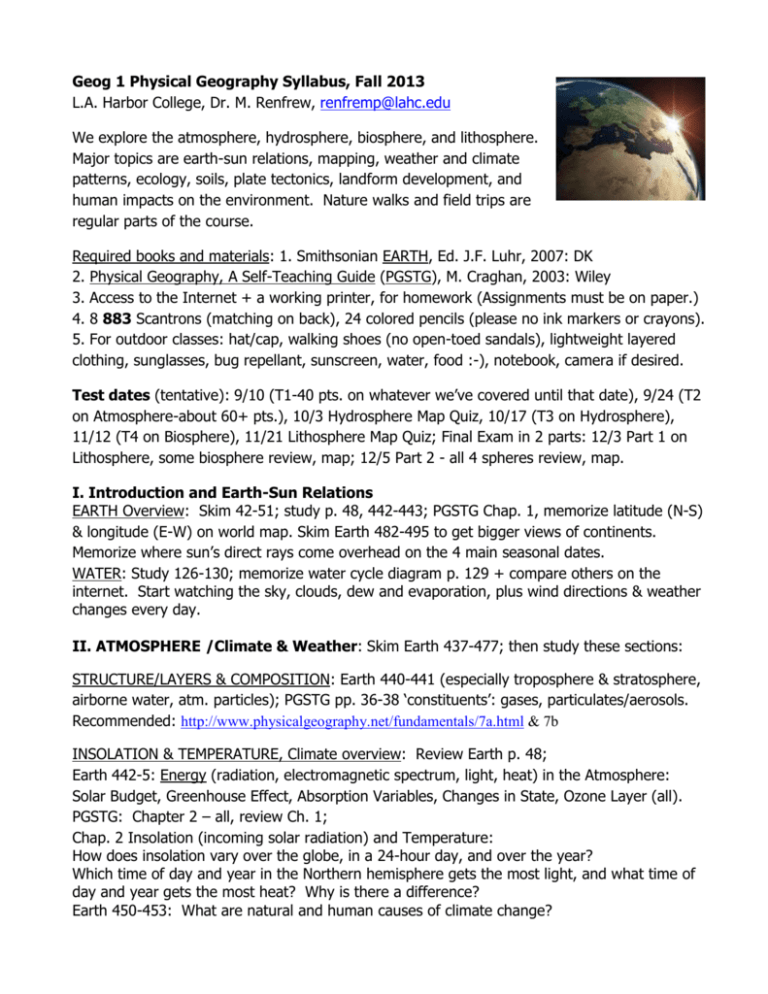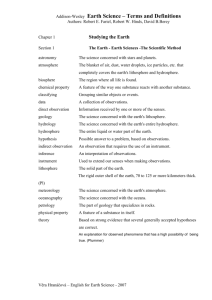Geography 1 Physical Geography
advertisement

Geog 1 Physical Geography Syllabus, Fall 2013 L.A. Harbor College, Dr. M. Renfrew, renfremp@lahc.edu We explore the atmosphere, hydrosphere, biosphere, and lithosphere. Major topics are earth-sun relations, mapping, weather and climate patterns, ecology, soils, plate tectonics, landform development, and human impacts on the environment. Nature walks and field trips are regular parts of the course. Required books and materials: 1. Smithsonian EARTH, Ed. J.F. Luhr, 2007: DK 2. Physical Geography, A Self-Teaching Guide (PGSTG), M. Craghan, 2003: Wiley 3. Access to the Internet + a working printer, for homework (Assignments must be on paper.) 4. 8 883 Scantrons (matching on back), 24 colored pencils (please no ink markers or crayons). 5. For outdoor classes: hat/cap, walking shoes (no open-toed sandals), lightweight layered clothing, sunglasses, bug repellant, sunscreen, water, food :-), notebook, camera if desired. Test dates (tentative): 9/10 (T1-40 pts. on whatever we’ve covered until that date), 9/24 (T2 on Atmosphere-about 60+ pts.), 10/3 Hydrosphere Map Quiz, 10/17 (T3 on Hydrosphere), 11/12 (T4 on Biosphere), 11/21 Lithosphere Map Quiz; Final Exam in 2 parts: 12/3 Part 1 on Lithosphere, some biosphere review, map; 12/5 Part 2 - all 4 spheres review, map. I. Introduction and Earth-Sun Relations EARTH Overview: Skim 42-51; study p. 48, 442-443; PGSTG Chap. 1, memorize latitude (N-S) & longitude (E-W) on world map. Skim Earth 482-495 to get bigger views of continents. Memorize where sun’s direct rays come overhead on the 4 main seasonal dates. WATER: Study 126-130; memorize water cycle diagram p. 129 + compare others on the internet. Start watching the sky, clouds, dew and evaporation, plus wind directions & weather changes every day. II. ATMOSPHERE /Climate & Weather: Skim Earth 437-477; then study these sections: STRUCTURE/LAYERS & COMPOSITION: Earth 440-441 (especially troposphere & stratosphere, airborne water, atm. particles); PGSTG pp. 36-38 ‘constituents’: gases, particulates/aerosols. Recommended: http://www.physicalgeography.net/fundamentals/7a.html & 7b INSOLATION & TEMPERATURE, Climate overview: Review Earth p. 48; Earth 442-5: Energy (radiation, electromagnetic spectrum, light, heat) in the Atmosphere: Solar Budget, Greenhouse Effect, Absorption Variables, Changes in State, Ozone Layer (all). PGSTG: Chapter 2 – all, review Ch. 1; Chap. 2 Insolation (incoming solar radiation) and Temperature: How does insolation vary over the globe, in a 24-hour day, and over the year? Which time of day and year in the Northern hemisphere gets the most light, and what time of day and year gets the most heat? Why is there a difference? Earth 450-453: What are natural and human causes of climate change? Hot & warm climate regions in low & middle latitudes: read, study maps 454-6. Cool & cold regions in mid- & high latitudes & mountains: read, study maps 456-7; see Biome map 134-5. PGSTG: page through Ch. 7 Climate. ATMOSPHERIC WATER: vapor/humidity (invisible), condensation (clouds, dew), precipitation. Earth: review 128-9, 441- Airborne water, 443- Changes in state, 448- Moisture & oceans; 466-473: Precipitation & Clouds, Stable & Unstable Air, Condensation, Lifting & Rainfall, Rain, Hail & Snow, Fog & Dew, Frost; Cloud Types: know by altitude, shape. PGSTG Chap. 3 Atmospheric Water: all (except relative humidity equations) Recommended: http://www.physicalgeography.net/fundamentals/7t.html AIR PRESSURE & WINDS: Earth 474-477 All; 446-449: Atmospheric Circulation PGSTG: Chap. 4 Pressure and Wind: How wind moves, Coriolis force, Low and High-pressure centers (cyclones and anticyclones), Pressure Systems and Vertical Air Movement Chap. 5 General Circulation of the Atmosphere: all Required reading: http://www.physicalgeography.net/fundamentals/7o.html Know easterly trades (tropics) & mid-latitude westerlies, jet streams, Asian and our summer monsoons, source directions of our local weather, sea & land breezes, Santa Anas (from NE), Catalina/coastal Eddy (from SE), mountain & valley winds (see web link), and everything gone over in class! Recommended: http://www.physicalgeography.net/fundamentals/7q.html AIR MASSES & WEATHER PATTERNS (that combine all elements): Earth 459-62 Air Masses & Pressure Systems, Mid-Latitude Depressions (same as “extratropical” or midlatitude cyclones): cold & warm fronts - how they affect us & move across U.S. 463-465 Tropical Cyclones (hurricanes, typhoons), Monsoon systems, Living with Hurricanes PGSTG Chap. 6 Air Masses and Storms: all Recommended: http://www.physicalgeography.net/fundamentals/7r.html, Required: http://www.physicalgeography.net/fundamentals/7s.html Mid-latitude cyclone section II. HYDROSPHERE: Map Quiz on rivers & seas locations: 10/3 Study guide to come. EARTH: Water 126-129; Rivers 210-215, Skim 216-235; Lakes 236, Skim 237-251; Glaciers Skim 261-265; Oceans & Seas 396-7, 383-384, Circulation & Currents 390-1 Physical Geography Self-Teaching Guide: 12 Groundwater, 13 Streams, 15 Waves & Tides. Skim EARTH Coast section 427-435. III. BIOSPHERE: Geography of LIFE Be ready for 3 nature walks. Study guide to come. EARTH: Soil 100, skim 101-3; 282-343: Deserts, Forests, Wetlands, Grasslands, Tundra: study overview pages, skim examples. Climates 450-457. PGSTG: Chap. 7 Climate IV. LITHOSPHERE (Earth’s crust, upper mantle) EARTH: Detailed study guide to come. PGSTG: Chapters 8-9 Plate Tectonics & Interactions, 10 Volcanoes & Earthquakes, 11 Weathering, 12 Groundwater, 13 Streams, 14 Ice. Dr. Renfrew’s Office Hours, SCC 107 or 109: TTh 12:35-1 (& longer if needed), TTh 4-5, W 6-7, and by appointment, renfremp@lahc.edu, 310-233-4557. When you have tutoring-typeneed questions, please ask in class, so I can explain it to other students who may also need alternate wording or diagrams to grasp it. Student Learning Outcomes (sample): 1. Identify locations with Earth’s reference grid of latitude and longitude; relate latitude with incoming solar radiation and climate types. (Introduction, Atmosphere) 2. Differentiate common patterns of temperatures, high and low pressure, global and local winds, humidity and precipitation. (Atmosphere, Hydrosphere) 3. Correlate world maps of plate tectonics, volcanoes and earthquakes; and distinguish landforms associated with convergent, divergent, and transform (transverse) plate tectonic boundaries. (Lithosphere) 4. Recognize and illustrate the roles of water and wind in shaping vegetation patterns, and fluvial (river), coastal, Karst (groundwater in solution), desert, and glacial landforms. (Hydrosphere, Atmosphere, Biosphere, Lithosphere) 5. Compare and contrast Earth’s climates and biomes on a world map. (Atmosphere, Hydrosphere, Biosphere) Grading, Policies: A 90-100%, B 80-89%, C 68-79%, D 60-67%, F < 59%. • Your grade is not completely quantitative: Point totals from 4-5 tests @ 40-75 points, the final exam in 2 parts (150+ points), quizzes and homework make up about ¾ of your grade. • One weekend Field Trip Report is required, given a letter grade (2-4 pages of writing, plus 3 labeled drawings (specific plant showing its characteristics, specific rock, and landscape). Field Trip Reports describe our specific observations of Earth’s 4 spheres in that location: weather characteristics, water features, vegetation, animals, landforms, rocks, soil, and human activity in the area. (It is not an Internet paper, no copying.) • (About 10%) Letter grade on how hard you try: Participation & effort in class activities, respect, attendance, improvement on test and quiz scores, and effort to learn from mistakes. This can make a difference between grades. • EXTRA CREDIT only counts if you improve on tests, and Final Exam scores are C or above. You are welcome to come on several field trips if you like hiking and want to learn outdoors. • No make-up tests without emergency or illness: notify me that day. No make-up quizzes. • No cheating or copying at all. Any photos of tests (or taken from the room) will be considered cheating. • In the effort to promote an educational atmosphere, please respect everyone, no swearing, no interrupting or rudeness, and you may not sleep or walk in & out of class. It also helps other students if you do not wear perfumes, as many people are allergic to them. • Please put phones & ear phones completely away unless I assign an internet site in class. The class computers also are not for personal use or distraction. Try to “focus on learning geography” while you are in the classroom. • Our new Science Complex building does not allow any food or drinks except bottled water. I urge you to bring snacks & water, and eat before class if you can, so your brain has fuel & circulation. Please be especially careful to deposit trash completely because animal pests come out of the wetlands & rummage at night. We need to take care of our campus! • No smoking at all on campus, nature walks, or field trips, please. Latitude & longitude are a grid system for finding specific locations on Earth: 1. Locations are identified with 2 coordinates: L.A. is 34° N latitude, 118° W longitude. 2. Latitude measures 0°-90° N and S of the equator (0°). Lines of latitude are parallels, run E-W, but are showing positions North and South of equator. Climates are based on latitude because the most intense sun is in the “low latitudes,” 0°-30° N & S, which contain the tropics, 23.5° N–23.5° S. (2 Tropic lines are boundaries.) 30°-60° N & S = Mid-latitudes (where we live). 60°-90° N & S = High latitudes, including polar regions. 3. Longitude measures 0°-180° E and W of the Prime Meridian (0°) that runs through Greenwich, England, U.K. (just outside London). Lines of longitude are meridians: they run N-S on the map, but measure East and West locations. Meridians are not parallel, but converge at the poles. 4. Label the Tropic of Cancer, Tropic of Capricorn, Arctic & Antarctic Circles, equator, Prime Meridian, and Los Angeles on one of your world maps. 5. Bracket low, middle, & high latitudes on one side. Local Map Basics: 1. Find a map of L.A./Orange County region showing L.A. Basin, Santa Monica Mountains, San Gabriel Mountains, and Santa Ana Mountains, and sketch it on a separate piece of paper. Label physical geographic features and places you’d like to go. 2. Draw and label a compass with 8 directions, and make this a part of your mental map.








